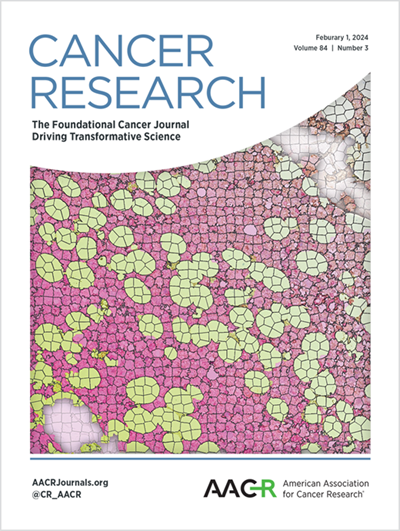铁性中性粒细胞诱导乳腺癌的免疫抑制和耐药性
IF 12.5
1区 医学
Q1 ONCOLOGY
引用次数: 0
摘要
诱导肿瘤细胞的铁变态反应正在成为治疗对传统治疗方法难治的恶性肿瘤的一种策略。然而,为了实现这种方法的潜力,我们需要更好地了解肿瘤微环境(TME)中免疫细胞铁突变的后果。在这项研究中,我们发现化疗耐药乳腺癌中的中性粒细胞对嗜铁细胞高度敏感。化疗耐药性相关中性粒细胞中酰基转移酶 MBOAT1 的减少诱导了磷脂的重编程,使其从偏好单不饱和脂肪酸转向多不饱和脂肪酸,从而增加了它们对铁凋亡的敏感性。铁变态中性粒细胞分泌 PGE2、IDO 和氧化脂质,抑制了抗肿瘤 CD8+ T 细胞的增殖和细胞毒性。此外,中性粒细胞铁嗜性与IL-1β+CXCL3+CD4+(Fer-CD4)T淋巴细胞的独特亚群密切相关,后者在化疗耐药肿瘤中富集。Fer-CD4 T细胞通过IL-1beta/IL-1R1/NF-kappaB信号调节MBOAT1的表达,从而协调中性粒细胞的铁突变。此外,Fer-CD4 T 细胞分泌 CXCL3、IL-8 和 S100A9 来补充 TME 中的中性粒细胞池。铁嗜中性粒细胞反过来又促进了 Fer-CD4 T 细胞的分化。在自发性肿瘤发生小鼠模型中,以IL-1β+ CD4+ T细胞或IL-1R1+中性粒细胞为靶点打破了串联,抑制了中性粒细胞铁嗜性,增强了抗肿瘤免疫力,克服了化疗耐药性。总之,这些发现揭示了中性粒细胞铁嗜性在形成免疫格局中的作用,并为恢复乳腺癌的免疫监视和化疗敏感性提出了有吸引力的靶点。本文章由计算机程序翻译,如有差异,请以英文原文为准。
Ferroptotic Neutrophils Induce Immunosuppression and Chemoresistance in Breast Cancer
Inducing ferroptosis in tumor cells is emerging as a strategy for treating malignancies that are refractory to traditional treatment modalities. However, the consequences of ferroptosis of immune cells in the tumor microenvironment (TME) need to be better understood in order to realize the potential of this approach. In this study, we discovered that neutrophils in chemoresistant breast cancer are highly sensitive to ferroptosis. Reduction of the acyltransferase MBOAT1 in chemoresistance-associated neutrophils induced phospholipid reprogramming, switching the preference from monounsaturated fatty acids to polyunsaturated fatty acids, which increased their susceptibility to ferroptosis. Ferroptotic neutrophils secreted PGE2, IDO and oxidized lipids that suppressed the proliferation and cytotoxicity of antitumor CD8+ T cells. Furthermore, neutrophil ferroptosis was closely related to a distinct subset of IL-1beta+CXCL3+CD4+ (Fer-CD4) T lymphocytes, which were enriched in chemoresistant tumors. Fer-CD4 T cells orchestrated neutrophil ferroptosis by modulating MBOAT1 expression via IL-1beta/IL-1R1/NF-kappaB signaling. Moreover, Fer-CD4 T cells secreted CXCL3, IL-8 and S100A9 to replenish the neutrophil pool in the TME. Ferroptotic neutrophils in turn fostered Fer-CD4 T cell differentiation. In spontaneous tumorigenesis mouse models, targeting IL-1beta+ CD4+ T cells or IL-1R1+ neutrophils broke the crosstalk, restraining neutrophil ferroptosis, enhancing antitumor immunity, and overcoming chemoresistance. Overall, these findings uncover the role of neutrophil ferroptosis in shaping the immune landscape and propose appealing targets for restoring immunosurveillance and chemosensitivity in breast cancer.
求助全文
通过发布文献求助,成功后即可免费获取论文全文。
去求助
来源期刊

Cancer research
医学-肿瘤学
CiteScore
16.10
自引率
0.90%
发文量
7677
审稿时长
2.5 months
期刊介绍:
Cancer Research, published by the American Association for Cancer Research (AACR), is a journal that focuses on impactful original studies, reviews, and opinion pieces relevant to the broad cancer research community. Manuscripts that present conceptual or technological advances leading to insights into cancer biology are particularly sought after. The journal also places emphasis on convergence science, which involves bridging multiple distinct areas of cancer research.
With primary subsections including Cancer Biology, Cancer Immunology, Cancer Metabolism and Molecular Mechanisms, Translational Cancer Biology, Cancer Landscapes, and Convergence Science, Cancer Research has a comprehensive scope. It is published twice a month and has one volume per year, with a print ISSN of 0008-5472 and an online ISSN of 1538-7445.
Cancer Research is abstracted and/or indexed in various databases and platforms, including BIOSIS Previews (R) Database, MEDLINE, Current Contents/Life Sciences, Current Contents/Clinical Medicine, Science Citation Index, Scopus, and Web of Science.
 求助内容:
求助内容: 应助结果提醒方式:
应助结果提醒方式:


